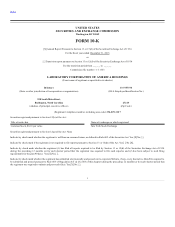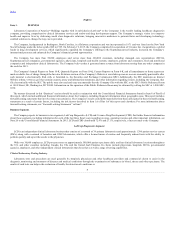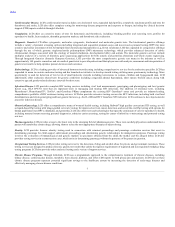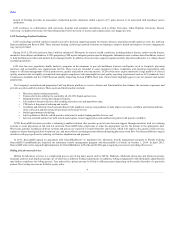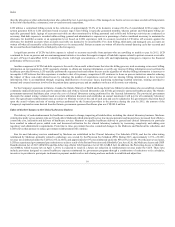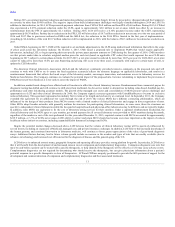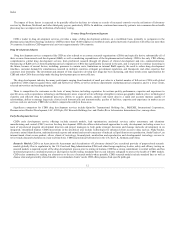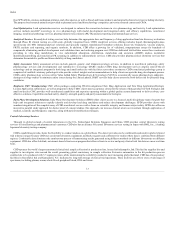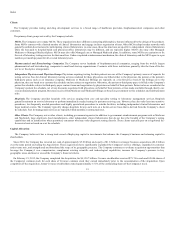LabCorp 2015 Annual Report Download - page 5
Download and view the complete annual report
Please find page 5 of the 2015 LabCorp annual report below. You can navigate through the pages in the report by either clicking on the pages listed below, or by using the keyword search tool below to find specific information within the annual report.
Index
pathogens and the selection of appropriate therapies. Clinical laboratory testing is generally categorized as either clinical pathology testing, which is
performed on body fluids including blood, or anatomical pathology testing, in which a pathologist examines histologic or cytologic samples (i.e., tissue and
other samples, including human cells). Clinical and anatomical pathology procedures are frequently ordered as part of regular physician office visits and
hospital admissions in connection with the diagnosis and treatment of illnesses. Certain of these tests and procedures are used in the diagnosis and
management of a wide variety of medical conditions such as cancer, infectious disease, endocrine disorders, cardiac disorders and genetic disease. It is
estimated that although laboratory services account for less than 3% of total U.S. healthcare spending (and less than 2% of Medicare expenditures), the
results of those tests influence approximately 70% of physician medical decisions.
The Company believes that in 2015, the U.S. clinical laboratory testing industry generated revenues of approximately $75.0 billion. The clinical
laboratory industry consists primarily of three types of providers: hospital-based laboratories, physician-office laboratories and independent clinical and
anatomical pathology laboratories, such as those operated by LCD. The clinical laboratory business is intensely competitive. The Centers for Medicare and
Medicaid Services (CMS) of the Department of Health and Human Services (HHS) has estimated that in 2015 there were approximately 9,000 hospital-based
laboratories, more than 122,000 physician-office laboratories and more than 6,000 independent clinical laboratories in the U.S. LCD competes with all of
those laboratories.
LCD believes that healthcare providers selecting a laboratory often consider the following factors, among others:
• accuracy, timeliness and consistency in reporting test results;
• reputation of the laboratory in the medical community or field of specialty;
• contractual relationships with MCOs;
• service capability and convenience offered by the laboratory;
• number and type of tests performed;
• connectivity solutions offered; and
• pricing of the laboratory’s services.
LCD believes that consolidation in the clinical laboratory testing business will continue. In addition, LCD believes that it and the other large
independent clinical laboratory testing companies will be able to increase their share of the overall clinical laboratory testing market due to a number of
factors, including cost efficiencies afforded by large-scale automated testing, mergers and acquisitions of complementary businesses, reimbursement
reductions and demands from health plans and other healthcare organizations for greater efficiency and large, integrated service networks. In addition, legal
restrictions on physician referrals and their ownership of laboratories, as well as increased regulation of laboratories, are expected to contribute to the
continuing consolidation of the industry.
Although testing for healthcare purposes and customers represents the most significant portion of clinical laboratory industry, clinical laboratories also
perform testing for other purposes and customers, including employment and occupational testing, DNA testing to determine parentage and to assist in
forensic investigations, environmental testing, veterinary testing, wellness testing, toxicology testing, pain management testing and nutritional analysis and
food safety testing.
LCD has a network of primary testing laboratories, specialty testing laboratories, branches, PSCs and STAT laboratories. A branch is a central facility that
collects specimens in a region for shipment to one of LCD’s laboratories for testing. A branch is also frequently used as a base for sales and distribution staff.
Generally, a PSC is a facility maintained by LCD to serve the patients of physicians in a medical professional building or other strategic location. The PSC
staff collect specimens for testing as requested by the physician. However, most patient specimens are collected in the customer's office by the customer's staff
or in some cases by an LCD in-office phlebotomist. The specimens, and test request forms if the test order was not placed electronically, are collected from
customer locations and, PSCs, and sent principally through LCD's in-house courier system (and, to a lesser extent, through independent couriers) to one of
LCD's primary testing laboratories for testing. Some of LCD's PSCs also function as STAT labs.
Each specimen and related request form is checked for completeness and given a unique identification number. The unique identification number
assigned to each specimen associates the results to the appropriate patient. The test request forms are sent to a data entry operator who enters the necessary
testing and billing information. Once this information is entered into the software system, the tests are performed and the results are entered through an
electronic data interchange interface or manually, depending upon the tests and the type of instrumentation involved. Most of LCD's automated testing
equipment is connected to its information
5

